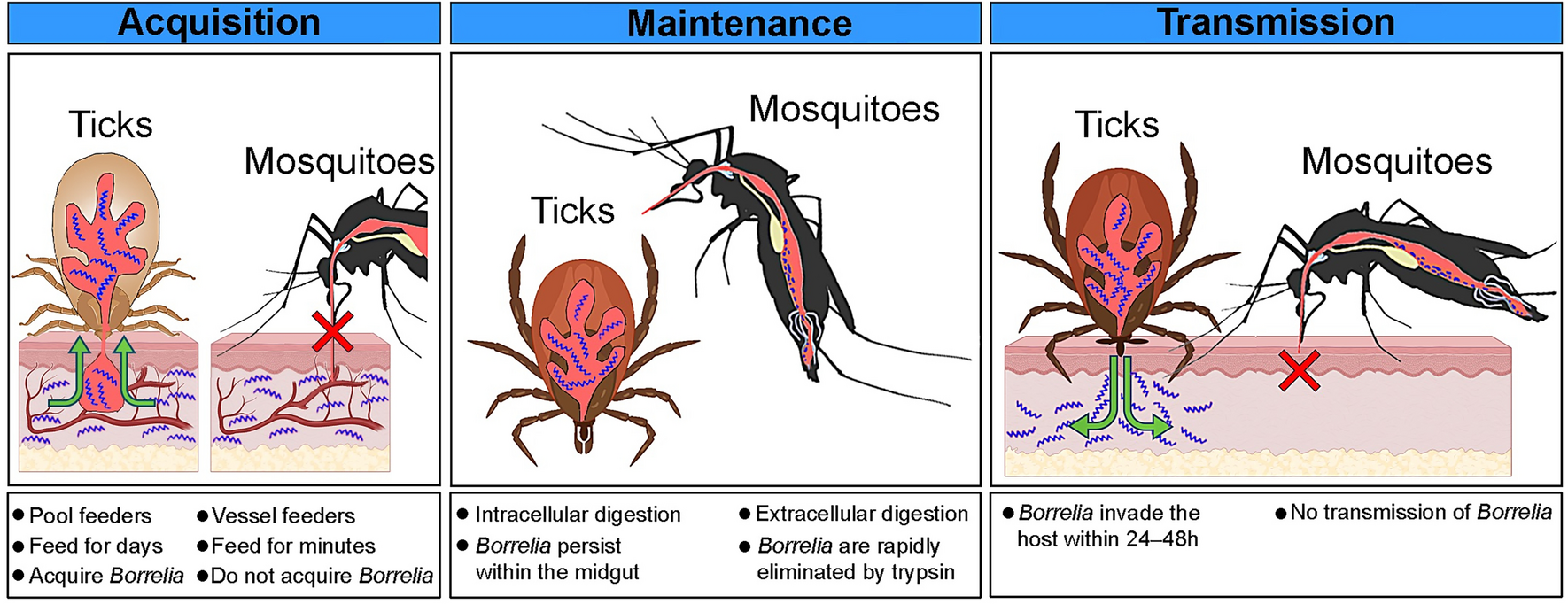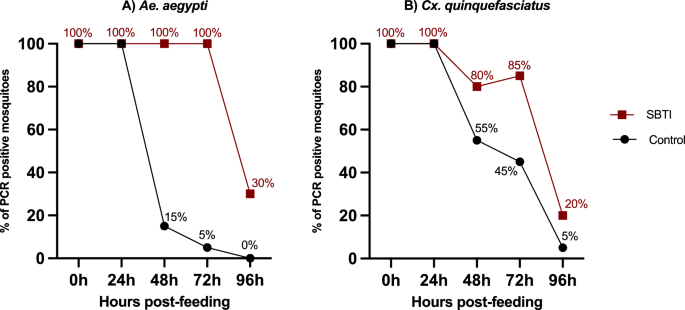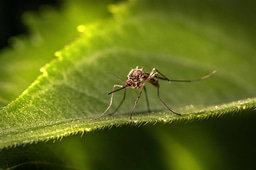The Vector Verdict: Mosquitoes Acquitted!
Published in Microbiology

Lyme disease is considered a public health concern in the Northern Hemisphere and is the most common vector-borne disease in Europe and the US. The disease is caused by spirochetes of the genus Borrelia and is transmitted by Ixodes ticks. However, various studies across Europe and the US show that many patients with Lyme disease do not recall a tick bite. Due to the painless nature of tick bites, compared to those of mosquitoes or horse flies for example, people are less likely to recall being bitten and more likely to associate their infection with a more memorable bite from another insect. The presence of Borrelia spirochetes has been noted in Culex and Aedes mosquitoes as well as horse flies and deer flies, adding to this idea that maybe Lyme disease was being spread by arthropods other than Ixodes ticks…
However, detection of spirochetes in other insects does not necessarily mean that they are a competent vector of that pathogen. To be this, an organism must have the ability to acquire, maintain and transmit the spirochetes. Ticks and mosquitoes are both blood feeding arthropods, but their feeding and digestion mechanisms differ. Pekľanská and colleagues undertook a variety of experiments to test whether mosquitoes (Aedes aegypti, Culex Quinquefasciatus, and Culex pipiens biotype molestus) could carry out these three processes with Lyme disease causing spirochetes (Borrelia burgdorferi, Borrelia afzelii and Borrelia garinii).

Acquisition
To test mosquito acquisition of Borrelia, mice were infected with the pathogen and then fed on by mosquitoes, who were later tested for the presence of spirochetes. PCR showed that only 15% of Aedes aegypti that fed on Borrelia burgdoferi infected mice tested positive, and in fact no spirochetes were detected in the other two species of mosquito, or Aedes mosquitoes that fed on Borrelia afzelii infected blood. Mosquitoes’ feeding behaviour is rapid compared to ticks, and it is likely that Borrelia has adapted to the ticks’ slower feeding behaviour. Therefore, there is a low probability of mosquitoes acquiring Lyme disease under natural conditions.
Maintenance
Tick and mosquito digestion mechanisms differ. Digestion in ticks is intracellular in the midgut, whereas in mosquitoes it is extracellular. To test if Borrelia spirochetes could be maintained inside the mosquito gut, chicken and mouse blood was spiked with spirochetes which were successfully introduced to mosquitoes via an artificial feeding unit. The viability and infectivity were then tested: After 24 hours, spirochetes were still detectable in all mosquitos, but gradually disappeared over 48, 72, and 96 hours post feeding ().
In mosquitoes, trypsin is the main digestive enzyme responsible for digesting a mosquito’s blood meal in the midgut. Pekľanská and colleagues undertook a second maintenance experiment using a trypsin inhibitor to test the enzyme’s effect on spirochete maintenance. When trypsin was inactivated, B. afzelii persistence was prolonged, with spirochetes detected in Aedes aegypti at 100% 72 hours post feeding, compared to 5% in controls, and at 85% vs 45% in controls in Culex Quinquefasciatus. Borrelia cultures treated directly with trypsin saw 97% spirochete death compared to 34% treated with inactivated trypsin, further indicating the enzyme’s ability to prevent Borrelia maintenance.

Pekľanská, M., Kuníková, K., Vlčková, R. et al. Experimental evidence rules out mosquitoes of Lyme
disease. Parasites Vectors 18, 206 (2025)
Transmission
For mosquitoes to transmit Lyme disease, Borrelia spirochetes would need to travel from the midgut to their salivary glands, which would also require Borrelia evading the mosquitoes’ immune response. To test spirochete transmission, mosquitoes were fed on feeding units with Borrelia spiked mouse blood and then allowed to feed on uninfected mice. Biopsies were collected four weeks after this, with no spirochetes detected in any of the mice. Whereas when the mice were fed on by Borrelia infected ticks, all became infected. The group also tested the possibility that mosquitoes could transmit spirochetes attached to their mouthparts, by moving the mosquitoes from the artificial feeding unit to uninfected mice mid-feed. However, again, none of the mice fed on by infected mosquitoes became infected themselves, showing mosquitoes inability to transmit Lyme disease naturally or mechanically.
Despite the detection of Borrelia in various arthropods, Pekľanská and colleagues’ research strengthens the consensus that mosquitoes are not competent vectors for Lyme disease. They cannot sufficiently acquire spirochetes during feeding on infected animals; any spirochetes that make it to the midgut are eliminated during digestion; and, even when infected artificially, they cannot transmit spirochetes to other organisms. This means Ixodes ticks are the sole competent vectors of Lyme disease and therefore should be the focus of control and prevention efforts.
Follow the Topic
-
Parasites & Vectors

This journal publishes articles on the biology of parasites, parasitic diseases, intermediate hosts, vectors and vector-borne pathogens.
-
BugBitten

A blog for the parasitology and vector biology community.
Related Collections
With Collections, you can get published faster and increase your visibility.
Artificial intelligence, parasites, and parasitic diseases
As discussed in this editorial by Dantas-Torres, this collection is dedicated to articles reporting the use of AI in parasitology research. We particularly welcome articles dealing with parasitic disease diagnosis, parasite and vector identification as well as those reporting the prospection of drugs and vaccine candidates.
This collection will serve as a platform for authors to publish their research that employs AI and deep learning methods for solving research questions in the fields of parasitology and tropical medicine.
Publishing Model: Open Access
Deadline: Dec 31, 2025
Climate Monitoring and Decision Support Framework for Sand Fly-borne Diseases Detection and Mitigation – The CLIMOS Project
Articles published in the collection have already gone through the systematic peer review process of the journal.
Publishing Model: Open Access
Deadline: Jan 31, 2026






Please sign in or register for FREE
If you are a registered user on Research Communities by Springer Nature, please sign in
What a great blog- love the title! Thanks for sharing, Freyja!